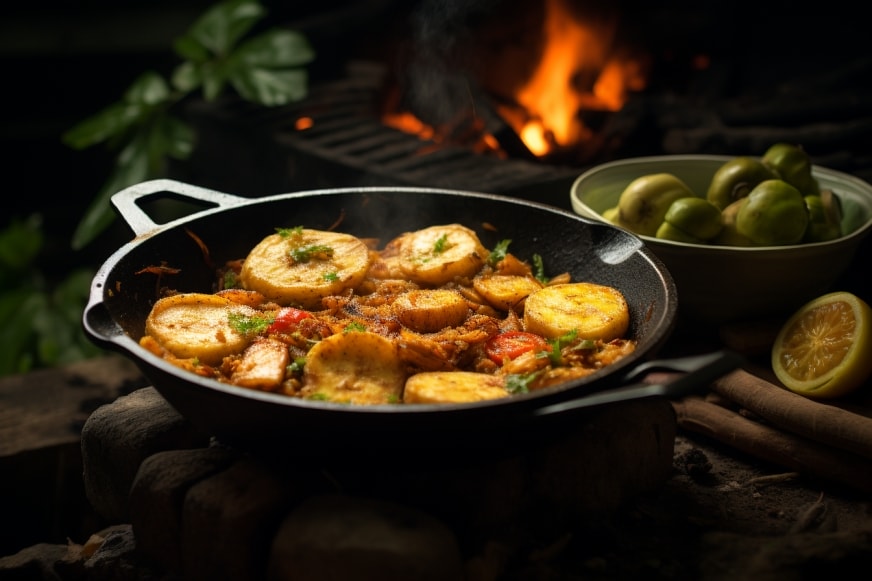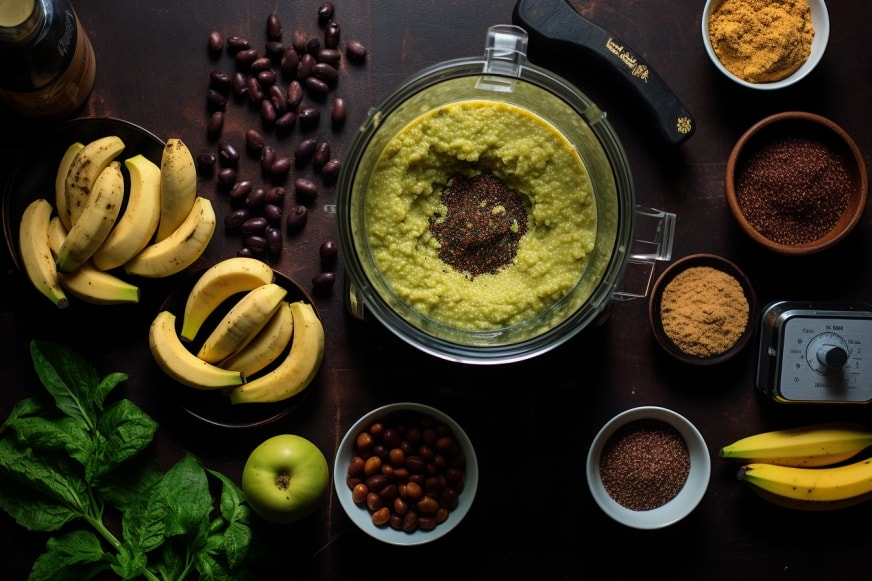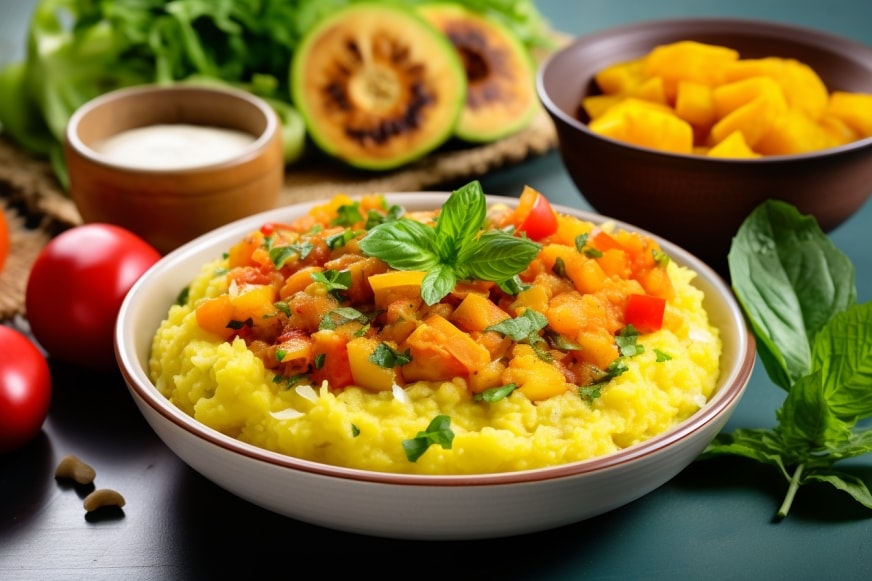Table of Contents
ToggleDominican Delicacy: Vegan Mangu (Mashed Plantains) for Babies
In the enchanting mosaic of Caribbean cuisine, the Dominican Republic emerges as a true culinary gem. Amidst the sun-kissed shores and vibrant rhythms, there lies a dish that embodies more than just flavor; it encapsulates generations of tradition and a tapestry of cultural heritage. Welcome to the world of Mangu, a heartwarming and iconic dish that has stood the test of time, evolving to become a beloved staple on Dominican tables. But today, we’re not just exploring its deliciousness; we’re venturing into uncharted territory – the world of Vegan Mangu for our precious little ones.
Mangu, pronounced mahn-goo, is more than a dish; it’s a testament to the Dominican soul. It hails from the Taino people, the indigenous inhabitants of the island who first cultivated the plantains that form the backbone of this dish. Imagine the lush landscapes and the intricate relationships between nature and culture that nurtured this humble ingredient, turning it into a beloved staple. Over time, Mangu’s story intertwined with the narratives of Spanish colonization and the forced migration of African cultures, ultimately resulting in a dish that boasts a fusion of flavors, techniques, and stories.
Picture a sunlit morning in a Dominican home, where the air is scented with the anticipation of a meal that transcends sustenance. Mangu has an uncanny ability to transform itself; it’s comfort food on a lazy Sunday, a hearty breakfast before a day of work, and a celebration of togetherness during festive occasions. This dish, humble and grand at the same time, has found its place in the hearts of Dominicans near and far.
But here’s where our journey takes a unique turn – the realm of our tiniest eaters. As a family care enthusiast with a Caribbean heritage, I find immense joy in sharing the flavors of my culture with my little ones. It’s not just about nourishing their bodies; it’s about nurturing their connection to their roots and the world around them. And so, Vegan Mangu steps into the spotlight, offering us a way to introduce our babies to the heartwarming tastes of the Caribbean while aligning with modern dietary preferences.
As we dive into this culinary expedition, let’s remember that food isn’t just about sustenance; it’s about sharing stories, preserving traditions, and creating memories. Vegan Mangu is more than a meal; it’s a window into Dominican history and culture. With each spoonful, we’re passing down flavors that have traveled through time, telling tales of resilience, adaptation, and unity.
So, join me as we embark on a journey that goes beyond ingredients and techniques. Let’s embark on a journey that connects us to the past, enriches our present, and lays the foundation for a future where our babies can savor not just the flavors, but the essence of a culture that’s as vibrant as the Caribbean sun.

Unveiling the Roots of Mangu
History, they say, is the tapestry upon which culture, flavors, and traditions are woven. In the case of Mangu, that tapestry is vibrant, intricate, and deeply rooted in the soil of the Dominican Republic. To truly appreciate the allure of this dish, we must first step back in time, tracing its origins to the Taino people – the indigenous inhabitants of the island.
The Taino, with their profound understanding of the land and its offerings, cultivated plantains as a dietary staple. These lush green fruits, versatile and abundant, held a special place in their cuisine. Plantains were not merely sustenance; they were a way of life, a symbol of their harmonious relationship with nature.
As the Taino way of life intersected with the arrival of Spanish explorers, a gastronomic crossroads emerged. Plantains, now embraced by the newcomers, became a bridge between worlds, symbolizing the fusion of cultures. Spanish culinary techniques and African influences melded with the native ingredients, giving rise to a dish that carried the essence of diversity.
Mangu’s journey didn’t end there; it continued to evolve as the Dominican Republic’s history unfurled. The dish found itself at the heart of family gatherings, celebrations, and everyday meals. It became a vessel for stories, a testament to resilience, and a reflection of unity. As Dominicans celebrated their cultural heritage, Mangu stood as a symbol of continuity, a thread that connected generations and embodied the nation’s rich identity.
Imagine the tables laden with Mangu, each plate telling a story of heritage. It’s a dish that doesn’t just feed the body; it nourishes the spirit, offering a taste of the past and a promise for the future. The plantains, now transformed into velvety mash, carry with them the weight of centuries, a history that’s both universal and deeply personal.
Today, as we bring Mangu to our babies’ palates, we’re not just introducing a dish; we’re offering them a journey through time. We’re inviting them to savor the flavors that have traveled across cultures and generations, reminding us that food is a conduit for stories and connections that transcend time and space.
So, as we prepare to craft Vegan Mangu for our little ones, let’s do so with a deep sense of appreciation for the roots that have shaped this dish. Let’s honor the Taino, the Spanish, the African, and all those who have contributed to Mangu’s journey. As our babies take their first bites, they’re not just tasting a meal; they’re tasting history, culture, and the essence of the Dominican Republic.

Crafting Mangu for Your Baby
Just like an artist delicately shapes a canvas, crafting Mangu for your baby requires a tender touch, a keen eye, and an understanding of textures that delight the senses. We’re not merely making a dish; we’re curating an experience that introduces our little ones to the magic of Dominican flavors. Here, in the heart of your kitchen, let’s embark on this culinary adventure.
Choosing the Perfect Plantains: Start with plantains that boast a golden hue and a gentle give when pressed. These ripe plantains are not just sweeter but also easier to digest, making them an ideal choice for your baby’s developing tummy. Remember, we’re aiming for a flavor profile that’s subtle and pleasing, ensuring that each spoonful is met with curiosity and delight.
Steam or Boil to Perfection: As we dive into the cooking process, you have two options: steaming or boiling. Both methods retain the plantains’ nutrients while creating a soft texture that’s perfect for mashing. Steaming preserves the vibrant color and enhances the natural sweetness, while boiling lends a slightly different character, allowing the plantains to soak in the flavors of the water. Whichever path you choose, remember that this is the foundation upon which your baby’s introduction to Mangu rests.
The Art of Mashing: Picture a ripe plantain, now tender from its steamy or watery bath. Here’s where the magic happens – the mashing process that transforms it into a velvety canvas of flavors. A fork or a potato masher will be your trusty tools; gently press down, applying just the right amount of pressure. The goal? A texture that’s smooth and free of lumps, ensuring that your baby’s first taste of Mangu is met with sheer delight.
Introducing Creaminess with Avocado: As we cater to our little one’s developing palate, let’s introduce an element of creaminess to our Mangu. Enter the avocado – nature’s butter, a source of healthy fats, and a palette of green that complements the plantains’ sweetness. Mash the avocado alongside the plantains, allowing their flavors to intertwine in a symphony of taste and texture. The result is a marriage of creaminess and natural sweetness that’s tailor-made for your baby’s budding palate.
A Hint of Tropical Magic: To round off our Mangu masterpiece, let’s infuse a hint of tropical magic. A touch of coconut oil is all it takes to elevate the flavors, transporting you to the sun-kissed shores of the Caribbean. This addition isn’t just about taste; it’s about creating a sensory experience that connects your baby to a world of vibrant colors, warm breezes, and the gentle rustling of palm leaves.
Serving Up a Culinary Adventure: With your Mangu masterpiece ready, it’s time to embark on a culinary adventure with your baby. Remember, this isn’t just a meal; it’s an introduction to the flavors that define Dominican culture. Present the Vegan Mangu in small, manageable portions, inviting your little one to explore the velvety texture, the subtle sweetness, and the comforting flavors that dance on their tongue.
As you watch your baby savor each bite of Vegan Mangu, know that you’re not just nourishing their body; you’re nourishing their connection to a rich heritage. You’re planting seeds of curiosity and appreciation for the culinary treasures that the world has to offer. So, with a spoon in hand and a heart full of excitement, let’s savor this moment of culinary creativity and watch as your baby takes their first steps into the flavorful world of Mangu.
Key Takeaways for Parents
| Takeaway | Explanation |
|---|---|
| Start Small and Observe | When introducing Mangu to your baby, begin with small portions. This allows you to gauge their response and detect any potential allergic reactions or sensitivities. Keep a watchful eye as you embark on this flavor-filled journey together. |
| Avocado: Creaminess and Nutrient Boost | Incorporating avocado into your baby’s Mangu not only adds creaminess but also introduces a dose of healthy fats. These fats are crucial for brain development and overall growth, making this dish not just delicious but incredibly nutritious. |
| Watch for Allergenicity | As with any new food, keep an eye out for potential allergenic reactions. Start by offering Mangu during the day, preferably in the morning. This ensures that you have ample time to monitor your baby and address any concerns that may arise. |
| Consult Your Pediatrician | Before introducing Mangu or any new food to your baby’s diet, it’s essential to consult your pediatrician. They can provide personalized guidance based on your baby’s unique dietary needs and health history. |
| Embrace Gradual Introduction | Mangu can be a wonderful addition to your baby’s menu, but remember that variety is key. Gradually introduce different foods and textures to ensure a well-rounded diet. As your baby explores the world of flavors, they’re also expanding their palate and nutritional intake. |
As parents, we’re not just nourishing our babies; we’re nurturing their curiosity, resilience, and appreciation for the world around them. These key takeaways offer guidance on how to navigate the introduction of Mangu to your baby’s diet. By keeping these insights in mind, you’re not just crafting meals; you’re cultivating a lifelong love for diverse flavors, cultures, and nourishment. So, as you embark on this culinary journey, know that you’re sowing the seeds of a healthy and flavorful future for your little one.

Nutritional Benefits for Your Baby
When it comes to nourishing our little ones, every bite matters. As we explore the nutritional landscape of Mangu, we uncover a treasure trove of goodness that goes beyond taste. The dish isn’t just a delightful melody of flavors; it’s a symphony of nutrients that supports your baby’s growth, development, and overall well-being.
Plantain Powerhouse: Ripe plantains, the heart and soul of Mangu, offer a wealth of nutritional benefits. Rich in dietary fiber, they promote healthy digestion, ensuring that your baby’s tummy is happy and content. This fiber also supports regular bowel movements, laying the foundation for a healthy gut – a cornerstone of overall wellness.
Essential Vitamins: Within the tender embrace of every plantain lies a bounty of vitamins that play a vital role in your baby’s development. Vitamin A, known for its importance in vision and immune health, contributes to your baby’s overall well-being. Vitamin C, an antioxidant powerhouse, aids in the absorption of iron and supports the immune system, creating a shield of protection as your baby explores the world around them.
Building Blocks with Vitamin B6: As your baby’s body grows and flourishes, the presence of vitamin B6 becomes essential. Found abundantly in plantains, this vitamin plays a role in brain development, nervous system function, and the production of neurotransmitters that regulate mood and behavior. With each spoonful of Mangu, you’re not just providing a meal; you’re offering building blocks for a bright future.
Healthy Fats and Brain Development: The addition of avocado to your baby’s Mangu introduces a touch of creaminess and a dose of healthy fats. These fats, often referred to as monounsaturated fats, are not only heart-healthy but also vital for brain development. As your baby’s brain rapidly grows and forms connections, these healthy fats serve as a source of nourishment for cognitive development.
Natural Sugars and Energy: The natural sugars present in plantains provide a gentle and sustained energy source for your little one. As they embark on their journey of exploration and growth, this natural boost of energy supports their active lifestyle. Unlike refined sugars, these natural sugars come packaged with fiber, ensuring that your baby’s energy levels remain steady and balanced.
With every bite of Vegan Mangu, your baby isn’t just tasting flavors; they’re reaping the rewards of a carefully curated dish that prioritizes both taste and nutrition. As parents, we understand the significance of these early culinary experiences. We’re not just introducing food; we’re shaping their relationship with nourishment and helping them develop a taste for wholesome goodness.
So, as you watch your baby delight in the flavors of Mangu, take a moment to appreciate the nutrition you’re providing. You’re not just serving a meal; you’re offering a feast of vitamins, minerals, and healthy fats that nourish their body, fuel their growth, and set the stage for a future where health and happiness go hand in hand.

Baby-Friendly Vegan Mangu Recipe
Prepare to embark on a culinary adventure that’s as heartwarming as it is nourishing. Our baby-friendly Vegan Mangu recipe captures the essence of Dominican flavors while catering to your little one’s developing palate. With each step, you’ll be crafting a dish that’s not just a meal; it’s a connection to culture, history, and the joy of sharing food with your baby.
Ingredients:
- Ripe plantains – 2
- Avocado – 1
- Coconut oil – 1 tablespoon
- A pinch of salt (optional)
Steps:
1. Prepare the Plantains:
Start by peeling and chopping the ripe plantains into evenly sized pieces. This ensures uniform cooking and a consistent texture for your Mangu.
2. Steam or Boil:
Choose your preferred method – steaming or boiling – to cook the plantains until they are tender. Steaming helps retain their vibrant color and natural sweetness, while boiling adds a slightly different dimension to the flavors.
3. Mash to Perfection:
Once your plantains are cooked to perfection, transfer them to a bowl and use a fork or potato masher to mash them into a smooth, lump-free consistency. This step is where the transformation from individual ingredients to a cohesive dish takes place.
4. Introduce Creaminess:
Halve the avocado, remove the pit, and scoop out the creamy flesh. Mash the avocado separately and then incorporate it into the mashed plantains. This not only enhances the texture but also introduces healthy fats that are essential for your baby’s growth and development.
5. Infuse the Tropical Flair:
Add a tablespoon of coconut oil to the mixture, gently folding it in. The coconut oil not only adds a hint of tropical flavor but also enriches the dish with its health benefits.
6. A Dash of Optional Flavor:
If you prefer, add a pinch of salt to the mixture. Remember that babies’ sodium intake should be limited, so use this sparingly and only if desired.
7. Serve and Savor:
Your baby-friendly Vegan Mangu is now ready to be savored! Serve it in small, manageable portions to your little one. As you watch them explore the flavors, textures, and tastes of this dish, you’re not just sharing a meal; you’re sharing a piece of your heritage and a love for wholesome, authentic cuisine.
A Culinary Legacy:
With this recipe, you’re not just preparing food; you’re carrying forward a legacy of flavors that have shaped generations. As your baby takes their first bite of Vegan Mangu, they’re not just savoring a dish; they’re experiencing a taste of the Dominican Republic and the love you put into every spoonful.
So, let your kitchen become a canvas of culinary creativity. Let the scents of plantains and avocado weave stories of culture and connection. And as you serve this dish to your little one, know that you’re nourishing more than just their body; you’re nourishing their curiosity, their heritage, and their love for the world’s diverse flavors.
As we draw the curtain on this culinary journey, we find ourselves in a space that transcends mere recipes and ingredients. Our exploration of Vegan Mangu has taken us through history, culture, and the art of nourishing our little ones. In the rhythm of each bite, we’ve uncovered not just flavors, but stories that weave through generations.
Picture the joy on your baby’s face as they experience the textures, the tastes, and the love that’s infused into every spoonful of Mangu. It’s more than just a dish; it’s a memory in the making, a snapshot of a moment that will remain etched in your hearts forever.
Through Mangu, we’ve bridged the gap between past and present, heritage and innovation. With every ingredient, every technique, and every shared meal, we’re nurturing a connection to the Dominican Republic that’s as enduring as it is delicious.
As parents, we wear the apron of storytellers, sharing tales of cultures, flavors, and traditions with every dish we serve. Our kitchens become classrooms of curiosity, teaching our babies about the world through their senses. With Vegan Mangu, we’ve not just fed their bodies; we’ve fed their souls with the richness of history and the thrill of discovery.
So, as you journey forward, remember that this is more than just a recipe; it’s an invitation to embrace the intersection of flavor and heritage. It’s a reminder that in each spoonful of Mangu, you’re nurturing a connection that spans continents and generations.
With every meal you prepare, you’re sowing the seeds of appreciation for diversity, the joy of discovery, and the beauty of sharing. As you watch your baby’s eyes light up with delight, you’ll know that you’ve embarked on a culinary adventure that goes beyond the confines of the kitchen.
Thank you for joining me on this exploration of Vegan Mangu for babies. May your kitchens continue to be a canvas of creativity, and may your plates be filled with not just food, but stories that nourish the heart and soul.
Want to take your knowledge to the next level? Check out these must-read articles:
- Antiguan Adventure: Vegan Caribbean Conch Chowder
- Caribbean Curry Cauliflower: Cauliflower and Chickpea Puree
Organize your baby’s wardrobe with our baby clothes closet organizer products! Our organizers are designed specifically for baby clothes. Get your baby’s clothes neat and tidy with our selection of organizers – shop now!
- The Organic Baby Food Debate: What Actually Matters - July 2, 2025
- The Science of Baby Hunger Cues: Reading Your Child’s Signals - April 28, 2025
- Bottle Acceptance Strategies for Breastfed Babies - April 27, 2025



